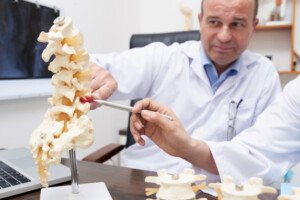Discover how spinal stenosis surgery can transform lives with benefits such as pain relief and enhanced mobility.
Find hope for a pain-free future.
The Benefits of Spinal Stenosis Surgery: Improving Quality of Life
Spinal stenosis is a debilitating condition that affects millions of people, affecting nearly 95% of those aged 50 or older.
It is characterized by the narrowing of the spinal canal, which puts unwelcome pressure on the spinal cord and nerve roots.

Spinal stenosis
Individuals suffering from spinal stenosis often endure distressing symptoms such as persistent back pain and numbness.
While conservative treatments like physical therapy and medication can provide relief for some, others may require surgical intervention.
Let’s walk through the benefits of spinal stenosis surgery and how it can significantly improve the quality of life for those with this condition.
Understanding Spinal Stenosis
Spinal stenosis happens when the space within the spinal column becomes too narrow.
This can occur in different parts of the spine, most commonly in the neck (cervical spinal stenosis) or lower back (lumbar spinal stenosis).
The root causes of spinal stenosis are primarily related to age-related changes in the spine.
These changes can include the development of bone spurs, herniated discs, or thickening of ligaments, all of which reduce the available space within the spinal canal.
Symptoms of Spinal Stenosis
Common symptoms of spinal stenosis include:
Back or neck pain: Pain in the back or neck is common, with the severity varying based on the location of the stenosis, and it can range from mild discomfort to debilitating.
Tingling sensations: Some individuals with spinal stenosis may feel tingling or “pins and needles” in their arms, legs, hands or feet.
Numbness or weakness: Patients may experience numbness or weakness in their limbs, which can affect mobility and coordination.
Difficulty walking: Lumbar spinal stenosis, in particular, can lead to difficulty walking, often described as a feeling of heaviness or fatigue in the legs.
Nonsurgical Treatment Options
Nonsurgical treatment alternatives for spinal stenosis include:
Physical therapy: Physical therapy focuses on enhancing strength, flexibility, and mobility while alleviating pain, making it particularly beneficial for those in the early stages of spinal stenosis.
Medication: Occasionally, doctors may prescribe anti-inflammatory medications and pain relievers to temporarily alleviate symptoms.
However, these medications would not address the underlying cause of spinal stenosis.
Epidural steroid injections: In some cases, epidural steroid injections can help reduce inflammation and alleviate pain.
However, the relief provided by these injections is often temporary.
Lifestyle modifications: Making lifestyle changes such as maintaining a healthy weight, staying physically active, and using assistive devices like braces or canes can help manage symptoms and improve overall quality of life.
Alternative therapies: Some individuals explore alternative therapies like chiropractic care, acupuncture or yoga to relieve pain and improve spinal flexibility.
However, the effectiveness of these treatments can vary from person to person.
Assistive devices: Using devices like a back brace or walking aid can help support the spine and reduce the strain on affected areas.
Pain management techniques: Techniques like heat or cold therapy, transcutaneous electrical nerve stimulation (TENS) and massage therapy may be able to alleviate pain and discomfort.
The Benefits of Spinal Stenosis Surgery
The benefits of spinal stenosis surgery can be significant for individuals with severe or debilitating symptoms who have not responded adequately to nonsurgical treatments.
Some potential benefits of spinal stenosis surgery include:
Pain relief: Spinal stenosis surgery can alleviate chronic and often severe back or leg pain associated with spinal stenosis, improving the individual’s comfort and quality of life.
Improved mobility: Surgery can restore mobility and physical function, allowing individuals to perform daily activities with greater ease.
Prevention of further nerve damage: Surgery aims to decompress the spinal canal, which can prevent further damage to the spinal cord and nerve roots, potentially halting the progression of neurological deficits.
Quick recovery: In many cases, surgical procedures for spinal stenosis are minimally invasive, leading to shorter hospital stays and faster recovery times compared to traditional open surgeries.
Reduced medication dependency: After successful surgery, some individuals may require fewer pain medications, reducing their reliance on pharmaceuticals.
Types of Spinal Stenosis Surgery
There are several types of spinal stenosis surgery, each designed to address the specific needs and conditions of the patient.
The choice of surgery depends on the location and severity of spinal stenosis and the patient’s overall health and preferences.
Here are some common types of spinal stenosis surgery:
1. Laminectomy: Also known as decompression surgery, a laminectomy involves the removal of the lamina (the bony arch of the vertebra) to create more space in the spinal canal.
This procedure relieves pressure on the spinal cord and nerve roots. It is a common surgical option for spinal stenosis.
2. Laminoplasty: Laminoplasty is similar to a laminectomy but involves reshaping the lamina rather than removing it.
This technique is often used for cervical spinal stenosis to maintain the spine’s stability while creating more space.
3. Foraminotomy: Foraminotomy is a procedure that enlarges the neural foramina, which are the openings through which nerve roots exit the spinal canal.
It is performed to relieve pressure on nerve roots due to foraminal stenosis.
4. Spinal fusion: Spinal fusion surgery involves joining two or more vertebrae together to stabilize the spine.
While it doesn’t directly address the narrowing of the spinal canal, it can be performed in conjunction with decompression surgery to add stability to the spine.
5. Artificial disc replacement: In this procedure, a damaged spinal disc is replaced with an artificial one.
It can be an alternative to spinal fusion and is used in specific cases, primarily for lumbar stenosis.
6. Interspinous spacer: An interspinous spacer is a small device inserted between the spinous processes (the bony protrusions on the back of the spine) to maintain the space between them and relieve pressure on the spinal cord and nerves.
7. Minimally invasive surgery: Various minimally invasive techniques, such as endoscopic or microsurgical procedures, are used to perform spinal stenosis surgery with smaller incisions, reduced tissue disruption and quicker recovery times compared to traditional open surgery.
The choice of surgery depends on the patient’s unique condition and the recommendations of their healthcare provider.
It’s essential to discuss the options, risks and potential benefits of each procedure thoroughly with a spine specialist to make an informed decision about the most suitable surgical approach.
Conclusion
Spinal stenosis surgery can be a life changing solution for individuals suffering from the debilitating effects of this condition.
It is a transformative path toward restoring not just physical comfort but also the overall quality of life.
If you or a loved-one is struggling with spinal stenosis, consult with a medical professional to explore the available treatment options, including the possibility of surgery.


 Mohamed M. Abdulhamid, MD,
Mohamed M. Abdulhamid, MD,







































